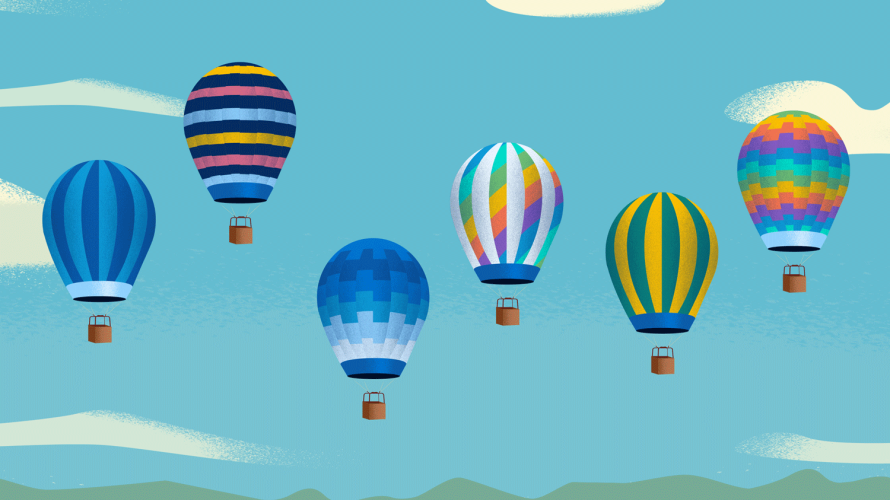As leaders, nourishing teams and organizational culture with virtual, hybrid, and shifting work dynamics can be challenging. When teams are global, it can be difficult to build trust and nurture relationships among team members. As the future of work is an ever-changing landscape, my team at Salesforce wondered what if we designed internal, team-building experiences with the same thoughtfulness we design experiences for customers?
I am a leader on the Design Operations (Design Ops) team at Salesforce. Our team works to design programs, processes, and experiences for design teams. We do it in the same way designers design for customers. It’s our responsibility to come up with ways for our teams to connect and have some fun – no matter where they are. My colleague Jason Kriese, vice president of user experience (UX) operations, believes, “Pulling a diverse group of folks together from across the globe and creating a space where you can see each other or interact in a meaningful way is crucial to team building.”
One of the ways we’re nurturing relationships among organization-wide designers is our Together Tour. We connected twelve design teams across AMER, EMEA, and APAC through a real-time, virtual, immersive event experience. Our purpose in holding this internal virtual event is to strengthen culture across our global community of designers and give them an opportunity to get to know their coworkers. To create the two-hour event we applied the same rigor, empathy, and process that our product designers do with customers and products.
Take the Relationship Design Trailhead Module
Discover how design can help build better relationships with customers and communities.



Here’s how we created an event to inspire connection across distributed teams.
Foster inclusion for authentic connection
Over the last year or so, we’ve learned a lot about how folks show up to work and team-building events in virtual spaces. One of the biggest lessons for me has been the realization fun is different for everyone. There’s no one-size-fits-all approach for creating spaces for people to connect. In fact, in many cases, these spaces can cause anxiety and alienation.

For example, not everyone does well with surprises. Often people don’t like to be put on the spot by being asked to respond to something. So starting a meeting with an icebreaker like asking everyone to quickly share a favorite childhood memory may be well-intentioned, but may make some participants uncomfortable. Instead, share a meeting agenda prior to the event. Make sure it includes details about what they will be expected to share. Then they can respond in a way that is appropriate for them, their mind space, and their interest level. It’s also important to create a reasonable way to decline or opt out of responding. Ultimately, it allows participants to show up in the way they want.
Prioritize fun and teams thrive
Our design for the Together Tour was not your average virtual event. We ask the attendees to roleplay and travel to the same virtual islands. So, that the journey isn’t only one of connection but of imagination. The event opened with a 15-minute welcome where three hosts, who were dressed up as balloon pilots, welcomed everyone and walked them through what to expect. Then everyone launched their personal hot air balloon with the press of a button. We all landed on the same virtual island and from there, participants could travel at their leisure to any of the nine activities over the course of two hours. At the end of the event, we brought everyone back together for a collective farewell.
The creative concept behind the event was a hot air balloon journey to a group of magical islands with nine different activities – five individual events and four scheduled moments to come together with a group. Participants could visit an art museum full of their coworkers’ creations, share their favorite recipes on the Meals that Make Us Island, and more.

When designing the Together Tour, one of the first decisions we had to make was around transportation. More specifically, how are people going to get around these virtual islands? Originally, we considered having everyone pretend to board a plane and fly over. But then how would they get around the islands once they were there? We wanted participants to have the autonomy to move at their own pace or take breaks when they needed them, which is why we decided to employ hot air balloons instead of airplanes.

Once you “landed” on the islands, “We wanted to create a space where no matter what your personality is, you could enjoy yourself,” said Maisee Xiong, lead design program manager at Salesforce. The Island Activity Tour was split between scheduled and self-service activities which allowed people to move at their own pace. They could take breaks from virtual meeting rooms by browsing the art museum and checking out paintings, sculptures, videos, and more made by colleagues. If they were feeling social, they could pop into a meeting room or chat on one of many Slack channels.
Justin Maguire, chief design officer at Salesforce, summarized the intention behind the Together Tour, “It’s been too long since we’ve had fun together as a team. How do we create a joy day for folks – time for play where we don’t talk about work?” Leadership is responsible for communicating the value of making time for everyone to have fun together. Ethan Eismann, vice president of design at Slack, echoes this sentiment, “As leaders, one of the new challenges is being accountable for the personal and mental wellbeing of your team. We are finding new practices that are necessary to lead through these challenging times.”
Design the event to ground people in the experience
From the beginning of the Together Tour, we wanted to push beyond feeling static or isolated by grounding people in the experience. A lot of thought and intention went into designing the event so it seemed like we were really there with our whole design team.

Quizzes and Matching Games tested participant’s knowledge of our Salesforce design team. Designers could take an architecture tour that doubled as a volunteer experience. With Zooniverse, attendees helped The Courtauld Institute of Art digitize their architecture photo collection. We had over 30 hours total of VTO (volunteer time) from this.
Clearing our calendars for a few hours of fun may seem silly, even irresponsible. But when teams are spread out geographically and juggling work and life in the pandemic, nurturing relationships and taking time to connect can mean the difference between thriving or stagnant teams.
As we shape the future of work we want to see, it’s going to be important to create space for different types of fun and to be inclusive of individual mindsets.
Work with everyday tools to create thoughtful and affordable events
You don’t need a huge budget or expensive tools to bring an event to life for your teams. In the feedback survey, no one suggested they needed or wanted a more high-tech experience. They were instead impressed by the amount of thought and consideration that went into making the space for people to connect.
To create the Together Tour, we used everyday tools like Slack, Google Slides, iMovie, and more. The art museum fostered fantastic connections between people but the production was minimal. We simply asked folks on the design team to submit their artwork. We then put the submission in a Google Slides deck and let people explore it at their own pace.

Slack has become a pivotal tool in fostering ongoing connections. During the event, people could join different channels to talk about art, food, or design and those channels are still open and active today. For instance, people are still sharing recipes and asking questions about cooking on the Meals that Made Us Slack channel. According to Brennan Hartich, senior director of design operations at Slack, “One way COVID helped shape our team culture was that I could come back after taking leave and catch up on team updates asynchronously. I was able to read back on all the content that had been shared in the Slack channel history. Now, I never miss a beat.”
Video was a big part of this event because using videos instead of live presentations freed us up to show them across different time zones.
We utilized Postsnap to enable the team to send Gratitude Postcards. The idea was to create a physical touchpoint in our isolated pandemic world where people could go online to design and write a card to someone they want to express gratitude for. It was an easy, thoughtful touch that was tied to the theme of travel and adventure.

Another tool that helped us create an interactive experience was the Heroku app. Chris Bill, our lead product designer, was able to create an immersive, real-time, delightful exploration of the islands. Some key features allowed participants to feel like they were playing a video game and find fun visual and functional easter eggs. A real-time effect was possible with countdowns and live-player pieces. Although Heroku is not an everyday tool, you can start using the app for free and add features as needed, so it’s budget-friendly for any team.
Virtual and hybrid events are the future of work. This means organizations will need to be more intentional and thoughtful about the spaces they create for their teams. These opportunities to connect don’t require big budgets but do require a free heart-first approach.
Keep learning and iterating to create the future we want to see
The future of work is full of new and exciting opportunities to create meaningful events for teams, both in person and at home. We learned a lot from the Together Tour. For instance, Chris Bill, lead product designer, mentioned, “In the feedback, some people mentioned they would like more opportunities to connect one-to-one but when you’re building an event at that scale that’s really hard to do. Next time, I’d like to try and offer that. But overall, people seemed really happy and grateful which makes it all worth it.” We’re looking forward to making the next event even better.
Currently, we are working on nurturing the relationships that began during the Together Tour by keeping the islands, Slack channels, and conversations open. “A self-perpetuating culture is the hallmark of a healthy organization,” according to Eismann. “It’s important to get a positive cultural flywheel going.”
Explore Relationship Design
Take the Relationship Design Trailhead Module to learn how to design experiences that foster relationships.































